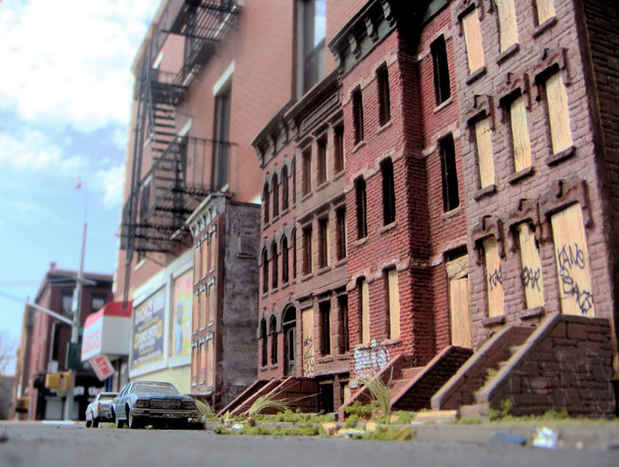Peter Feigenbaum “Trainset Ghetto: Streetsmart"
Open Source Gallery

This event has ended.
Peter shows a new series of large-scale photographs at Open Source Gallery based on a site-specific installation of his “Trainset Ghetto” sets on the street in front of the gallery storefront space. The images will feature increasingly bizarre and phantasmagorical juxtapositions of time, scale, and neighborhood architectural vernaculars, in which his invented, rubble-strewn New York City 70s minature slum landscape collides with the almost-gentrified brownstone environment of south Park Slope.
Trainset Ghetto is voyeurism more than it is hobbyism. It is the physical byproduct of teenage suburban daydreams and attempts to live vicariously through an alien post-urban 1980s landscape that was in no way part of my quotidian existence–a landscape that I caught glimpses of through car rides down the Bruckner Expressway, Henry Chalfant’s graffiti photographs, and movies such as “The French Connection” and “Style Wars”. But this odd juxtaposition of lifestyles is a well-hidden text. I make few overt attempts to exploit this perverse juxtaposition of place and social circumstance in my photographs. Rather, the primary emphasis is always “setting the scene” in a hyper-real, trompe l’oeil manner. Unlike other “scene-setting” photographers like James Cassebere, who works with hazy spatial ambiance, or Gregory Crewdson, who creates uncanny cinematic narratives, Trainset Ghetto is concerned primarily with hyper-realism via an attention to small mundane details of the urban architectural vernacular.
Trainset Ghetto is a by-product of the virtual urban spatial realms that defined my teenage experience in the 1990s-virtual realms found in video games ranging from Sim City to Duke Nuke ‘Em to Grand Theft Auto. The motivation to create Trainset Ghetto was cultivated by experiences in these virtual realms. Additionally, there was a desire to objectify these spatial experiences-a desire that could only be fulfilled via miniaturization, a process in which inhabitable spaces become tangible objects. While artists such as Corey Arcangel have responded to the digital realm of the 1990s using similarly digital means, Trainset Ghetto uses anachronistic, analogue means–the age-old pseudo-craft of model railroading.
Trainset Ghetto is not simply a “cheap holiday in other people’s misery”– it is a rigorous examination of the urban architectural vernacular. And it is more than a simple replicationÑit is an attempt to understand the metaphysics of place within an urban context.
The urban fabric and vernacular architecture of New York is both perpetually familiar and perpetually unfamiliar. Thus my scenes attempt to exploit this ambiguity of place-the feeling of remembering a place that one has never actually visited.
Accordingly, the scenes depicted in my photographs and models have never existed in reality, rather they were informed by vague memories (both real and “cinematically” implanted) of experiences in various parts of New York City. Perhaps the most important components of this vernacular include rooftop water tanks, 25-foot-wide five-story walkups, Italianate cornices, ancient brick facades painted Pepto-Bismol pink, roll-up store-front grates, parapet graffiti, and garish plastic storefront awnings. All of these details I have studied and re-created in miniature with great care.
Thus, Trainset Ghetto achieves hyper-reality, which Jean Baudrillard describes as a simulation of something that never actually existed. The project could also be seen as a perverse parallel to the other great American architectural hyper-reality: Disneyland.
From a stock of nearly fifty buildings created both from scratch and from model railroad structure kits. I can compose an endless array of believable scenes that are brilliantly generic, and almost capable of implanting false memories of my 1970s childhood in the bombed-out Bronx that never happened.
Media
Schedule
from September 04, 2010 to September 30, 2010
Opening Reception on 2010-09-04 from 19:00 to 22:00